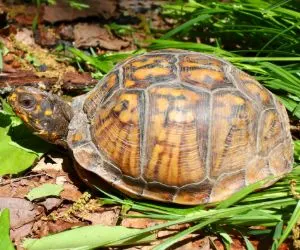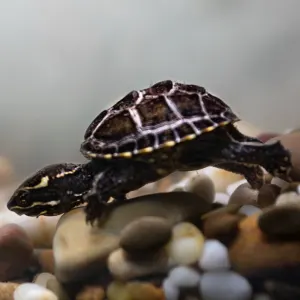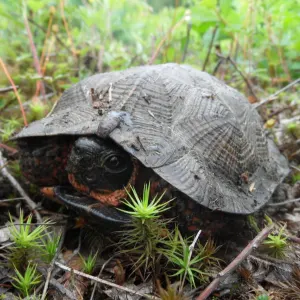There are eight species of turtles in New Hampshire, all of which are freshwater species. As one of the smaller states in the US, there are fewer habitats suitable for a wide range of turtles. Some of New Hampshire’s seven native turtles, such as Painted turtles, are found in most regions. But other species, like the Eastern Box turtle, are extremely rare and found only in select areas.
There have also been sightings of a non-native species in New Hampshire; the Red-eared Slider. These semi-aquatic turtles can be considered as invasive and can quickly dominate new regions. It’s likely that the Red-eared Sliders found in the Granite State were former captive specimens that were released unsafely.
This list is best utilized as a field herping guide for when you’re out on the trails. Alternatively, you can use it as a basis for deciding on your next pet turtle. In New Hampshire, it’s legal to possess all of the state’s native species as long as you have the relevant permit. Some of the more common species are exempt from requiring ownership permits, but do have possession limits.
If you do have to purchase a turtle, aim to secure a captive-bred specimen from a registered breeder. Although it is legal to take native turtles from the wild in New Hampshire, we strongly advise against this as it harms native populations.
Now, let’s take a look at the eight species of turtles in New Hampshire.
Turtles in New Hampshire
1. Blanding’s Turtle

- Experience Level: Intermediate
- Family: Emydidae
- Scientific Name: Emydoidea blandingii
- Other Names: N/A
- Adult Size: 5 to 8 inches (12.5 to 20 cm)
- Lifespan: Up to 80 years
- Average Price Range: $300 to $450
These semi-aquatic turtles, which are named after 18th Century American naturalist William Blanding, are considered to be Endangered in New Hampshire. They can be found in southeastern areas of the state, where they prefer marshy and wetland habitats with stagnant water sources.
Blanding’s turtles have black to dark brown shells with several yellow spots. These shells are oval-shaped. Their plastrons are yellow with black patches and they also have yellow throats, which is their most distinctive feature.
Blanding’s turtles consume crustaceans, insects, and mollusks. As part of an omnivorous diet, they will also occasionally eat plants.
2. Eastern Box Turtle

- Experience Level: Beginner
- Family: Emydidae
- Scientific Name: Terrapene carolina carolina
- Other Names: Common Box turtle, Land turtle
- Adult Size: 4 to 7 inches (10 to 18 cm)
- Lifespan: Up to 40 years
- Average Price Range: $120 to $400
Eastern Box turtles are one of New Hampshire’s rarest species. These State Endangered turtles were originally believed to be more widespread, but have sadly dwindled to just two recorded populations in southern areas, where they inhabit grasslands and woodlands that offer access to ponds.
Eastern Box turtles have dark brown shells with high domes and striking yellow and orange dot and stripe markings. Their brown skin is covered with more orange markings, while their plastrons are also dark brown and are concave in males but flatter in females.
These terrestrial turtles can roam up to 50 meters a day in search of food for their omnivorous diet, which usually consists of small fish, insects, and mollusks along with fruits and other vegetation. They will also sometimes scavenge on carrion.
3. Common Musk Turtle

- Experience Level: Intermediate
- Family: Kinosternidae
- Scientific Name: Sternotherus odoratus
- Other Names: Eastern Musk turtle, Stinkpot
- Adult Size: 4 to 5 inches (10 to 12.5 cm)
- Lifespan: 50+ years
- Average Price Range: $20 to $90
Common Musk turtles are a small aquatic species that are mainly found in southern areas of New Hampshire in boggy or marshy habitats with clear, slow-moving waters. Common Musk turtles are also affectionately know as “Stinkpots” thanks to the potent odor that they can release from their musk glands as a defense mechanism.
Common Musk turtles have black to dark brown or gray-green shells that lack distinctive markings. Their slightly pointed heads have two yellowish stripes on their long necks, which stand out from their dark skin. They also have fleshy barbels on both their chins and throats.
These small turtles are nocturnal omnivores that mainly eat small amphibians, crustaceans, and mollusks. They prefer to hunt using the cover of dense aquatic vegetation.
4. Painted Turtles

- Experience Level: Beginner
- Family: Emydidae
- Scientific Name: Chrysemys picta picta (Eastern), Chrysemys picta marginata (Midland)
- Other Names: N/A
- Adult Size: 4 to 10 inches (10 to 25.5 cm)
- Lifespan: 30 to 50 years
- Average Price Range: $20 to $50
There are two subspecies of Painted turtles native to New Hampshire – Eastern Painted turtles and Midland Painted turtles. Both species tend to overlap in central areas of the state, with Eastern Painted turtles being dominant in extreme southern counties. Neither subspecies is found in extreme northern regions.
Painted turtles have black or dark brown shells and tan to yellowish plastrons. Their faces and throats have yellow stripe markings. It’s often difficult to separate Eastern and Midland Painted turtles, but Eastern Painted turtles have scutes that run in straight rows lines with pale front edges, unlike all other Painted turtle subspecies. Midland Painted turtles have a dark, shadow-like patches in the center of their plastrons.
These aquatic turtles prefer shallow waters such as marshes and ponds. Both subspecies are diurnal omnivores but have slightly different diets. Eastern Painted turtles prefer consuming small fish and plants, whilst Midland Painted turtles mainly eat insects and vegetation.
5. Common Snapping Turtle

- Experience Level: Intermediate to Expert
- Family: Chelydridae
- Scientific Name: Chelydra serpentina
- Other Names: Common Snapper, Eastern Snapping turtle, Snapper
- Adult Size: 8 to 20 inches (20 to 51 cm)
- Lifespan: 30 to 50 years
- Average Price Range: $20 to $40
Common Snapping turtles are one of New Hampshire’s most common species. They prefer larger bodies of water such as lakes or reservoirs and can be found in most counties except for extreme northern areas.
These large aquatic turtles are famous for their powerful, hooked beaks, strong claws, and long tails covered with saw-toothed spines. Their thick dark brown or green shells have three prominent ridges in the center.
Common Snappers aren’t picky eaters. They usually consume amphibians, fish, smaller turtles, and even waterbirds if they can catch them. They may also occasionally eat plant matter.
6. Spotted Turtle

- Experience Level: Intermediate to Expert
- Family: Emydidae
- Scientific Name: Clemmys guttata
- Other Names: Polka-dot turtle
- Adult Size: 4 to 5 inches (10 to 12.5 cm)
- Lifespan: 25 to 50 years
- Average Price Range: $75 to $100
Spotted turtles are a semi-aquatic species found in boggy and marshy habitats at low elevations. They also like to have access to shallow waters. In New Hampshire, Spotted turtles are classed as Threatened and are found only in southeastern counties.
Spotted turtles have smooth black shells covered with their eponymous yellow spots. Their plastrons are also yellow and have large black patches of varying sizes on either side. Spotted turtles can also be identified by the yellow, orange, or red patches on their cheeks and chins.
Spotted turtles are omnivores that usually eat a diet of crustaceans, insects, and mollusks. They may also occasionally eat vegetation for some variety and nutrients.
7. Wood Turtle

- Experience Level: Intermediate
- Family: Emydidae
- Scientific Name: Glyptemys insculpta
- Other Names: N/A
- Adult Size: 5.5 to 8 inches (14 to 20 cm)
- Lifespan: 40 to 60 years
- Average Price Range: $250 to $500
The last of New Hampshire’s native species is the Wood turtle, which are listed as a species of Special Concern. These turtles inhabit woodland areas with access to shallow, slow-moving ponds and streams that have sandy bottoms. They are found in several parts of the state except for highland areas.
Wood turtles have beautiful dark brown shells that look as if they’ve been sculpped from wood. Patterns that resemble growth rings and wood grain are found on their scutes, which can also appear rough and may protrude from their shells.
Wood turtles roam widely while foraging for berries, plants, insects, and mollusks. They have a neat trick up their shells too – they can drum their feet on the ground to tempt earthworms, who mistakenly believe that it is raining, up to the surface.
One non-native species has also been sighted in parts of New Hampshire – the Red-eared Slider. These medium-sized, semi-aquatic turtles can quickly become invasive and are often released unsafely by irresponsible and unprepared owners who bought them cheaply without knowing how big they would get.
8. Red-eared Slider

- Experience Level: Beginner
- Family: Emydidae
- Scientific Name: Trachemys scripta elegans
- Other Names: Red-eared Terrapin, Water Slider turtle
- Adult Size: 6 to 8 inches
- Lifespan: 20 to 40 years
- Average Price Range: $15 to $50
Red-eared Sliders are a popular pet turtle species, with babies often sold in pet stores across the country. These semi-aquatic turtles prefer warmer, slow-moving waters such as rivers and lakes and can become invasive very quickly when released into new areas.
Red-eared Sliders have olive green shells with yellowish stripes on their scutes. Their heads are dark brown. Their heads sport the eponymous red patches just behind their eyes, and they have yellow stripes running across their skin and up their throats.
These Sliders consume small fish, insects, and aquatic plants as part of an omnivorous diet. They can often be seen basking at the water’s edge while stacked on top of each other.
Frequently Asked Questions about New Hampshire’s turtles
What kind of turtles live in New Hampshire?
There are eight species of turtles that live in New Hampshire – seven native species and one non-native turtle. Some of New Hampshire’s native specimens, like the Common Snapping turtle and Painted turtles, are quite widespread and are found in most regions of the state.
Other species, such as the Eastern Box turtle and Spotted turtles, are either Threatened or Endangered and are confined only to small populations in specific areas of the state. Most of these rarer species can be found in New Hampshire’s southern or southeastern counties.
Red-eared Sliders are a non-native species that have nevertheless been spotted in scattered areas of New Hampshire. These turtles were likely released from captivity by owners who weren’t prepared to house them and didn’t donate the turtles to an animal shelter. Red-eared Sliders can multiply quickly in new areas and may pose a danger to native turtles.
Are turtles illegal in New Hampshire?
You can legally possess any turtles in New Hampshire, even Endangered or Threatened species such as Eastern Box turtles.
There are however some ownership regulations and possession limits in place regarding turtles.
It is illegal to own any of the four Protected species of New Hampshire’s turtles – Blanding’s turtles, Eastern Box turtles, Spotted turtles, or Wood turtles – without possessing the correct permit. As for the other three native species – Common Musk turtles, Eastern and Midland Painted turtles, and Common Snapping turtles – two specimens of each species may be owned without a permit.
It is illegal to sell any of New Hampshire’s native specimens. However, it is legal to import specimens of any of New Hampshire’s native turtles as long as they’ve been legally obtained and purchased in a different state. All imports require a permit to be legal and all specimens must be kept in enclosures at all times.
Can you kill Snapping turtles in New Hampshire?
It is legal to take and kill Snapping turtles in New Hampshire for the purpose of food. However, there are a few restrictions in place regarding the capture of these large freshwater turtles.
No species of native turtle, including Snapping turtles, may be collected or taken between May 15th and July 15th each year. During the rest of the year, any Snapping turtles caught in the wild must be hand-caught using tools like hand-held nets.
There are also size limits governing when it is legal to take a Common Snapping turtle. A specimen must have a carapace length of either less than six inches or between 12 and 15 inches to be allowed to be taken legally.
Conclusion
Well, that’s the end of our list of the eight turtles in New Hampshire. We’ve covered the Granite State’s seven native species, including Blanding’s turtles and Painted turtles, as well as a non-native species that has been spotted in the state – the Red-eared Slider.
This list works best when used as a field herping guide for identifying turtles out on the trail, but you can also use it as a stepping stone to find your next pet turtle. If you enjoyed this list and are interested in obtaining one of New Hampshire’s turtle species, feel free to leave a comment down below!
Other nearby states
